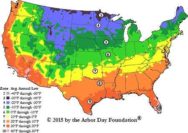
Understand Your Growing Zone

Growing your own food, and enough of it to last a while, is one of the pillars of living off the grid. Knowing about your Growing Zone is the key, allowing gardening off-grid to morp from a hobby to something vital to survival. And while there are other ways to put food on the table, gardening provides a balanced diet for the off-grid family as well as exercise and community.
A huge part of living off-grid involves understanding the area in which you are situated. Knowing your surroundings, including the success of past harvests, is essential to creating a garden that will sustain your lifestyle. Here are some tips for understanding your growing zone for a bountiful garden.
Know Your Spot on The Map
To understand your climate and growing zone, you need to know where your land falls on the USDA Plant Hardiness Zone Map. This useful tool assigns a number to each growing zone within the country. This number corresponds to how well different plants will grow in your area. For example, North Florida is in zone 8, which is great for growing apples. But you’ll have a tough time trying to grow grapes or cherries. Keep in mind that each growing region includes two subcategories as well. It’s possible that a plant that thrives in your growing zone won’t survive because of individual circumstances. However, staying with those plants rated for your growing zone number should help bring forth a bountiful harvest.
Know Your Soil
Another thing to consider when growing a substantial garden is the soil. You may have a wide range of plants in your growing zone, but not everything will do well in the ground on your property. Specific plants prefer a certain kind of soil that your land may not provide. You can add organic material to help fix soil conditions, but that doesn’t guarantee success.
Know Your Season
Northern homesteads will see cooler spring and fall seasons while southern ones will see plenty of hot weather. Different produce grows better in different seasons. It’s best to start out with cool-season vegetables like lettuce, peas, and broccoli well before hot weather arrives. If you’re living in the south, you may have no choice but to start with a warm weather crop like melons, zucchini, and cucumbers. Knowing your area and the average temperature for each season is vital to successfully sow seeds at the right time.
Know Past Weather Patterns
Taking note of past weather conditions within a season will help you understand and work your land better. Prolonged winter temperatures or a freak spring snowstorm can significantly decrease the amount of food that you can produce. Gardeners in Colorado know to wait until after Mother’s Day to plant. Yet the picture above was taken in late May, two weeks after the last forecast frost. …